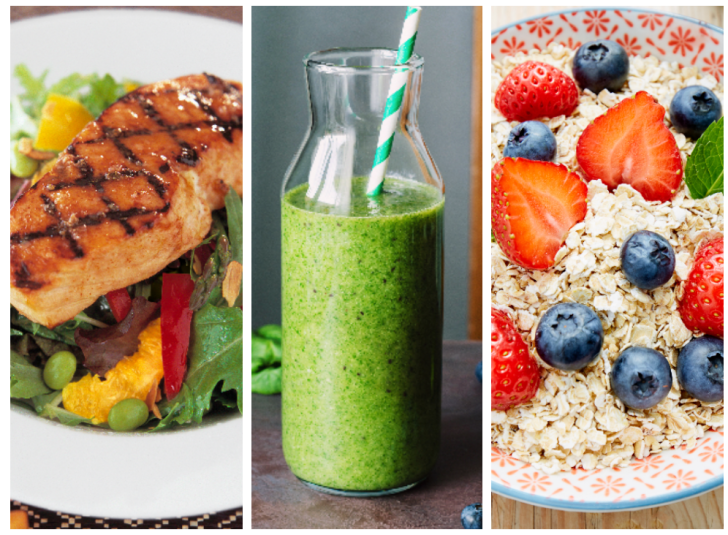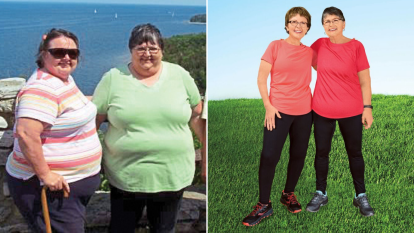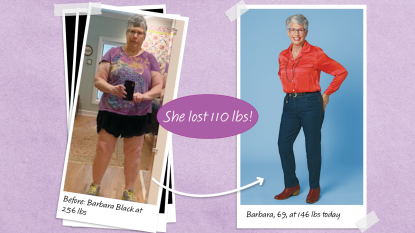There’s an African High-Fiber Diet That Can Turn Your Gut Bacteria Into Super Fat Busters

Not long ago, scientists realized that “trillions of bacteria living in our guts have a surprising effect on our weight,” according to Dr. Oz. As it turns out, lean folks have special types of bacteria that trigger healthy cravings, reduce calorie absorption, and boost metabolism. The rest of us, however, have types of bacteria that tend to promote weight gain. Do you suspect your bacteria is the fattening kind? Dr. Oz’s latest discovery could change that.
“People can’t stop talking about this,” Dr. Oz recently revealed. “It’s called the Hadza Diet.” The gist is that you mimic the eating habits of Africa’s Hadza tribe — a group that top researchers say boasts the absolute best gut bacteria — to improve your own gut bacteria by 20 percent within the first 72 hours. As you boost your bacteria, you’ll find that you lose weight far more easily — and end up far healthier, too.
Experts say they’ve been shocked to learn what a dramatic difference Hadza-style eating can make in an extremely short time frame. “This diet hit us from left field!” Dr. Oz declared.
Improving Gut Bacteria for Weight Loss: The Hadza Diet’s No. 1 Secret
So how did the Hadza people, who hunt and gather on the Serengeti Plains of Tanzania, end up with bacteria we should all want? It’s mostly because they eat enough fruit, root vegetables, and seeds to reach “a stunning 100 grams of fiber per day,” notes Butch Rosser, MD, who is Dr. Oz’s go-to Hadza authority. Though 100 grams isn’t realistic for most of us, the Hadza findings help explain why more practical fiber-packed approaches work so well. On the internet, high-fiber dieters even report shedding up to nine pounds in three days. But can fiber really help you lose that much? Here’s how to find out.
How to Improve Gut Bacteria for Weight Loss
What you eat: An average woman currently gets nine to 11 grams of fiber daily. Although some women can go as high as 40 grams right away, “I think 25 grams is a reasonable goal,” Dr. Oz said. The key is replacing a lot of the low-fiber foods you eat — especially added sugar and processed carbs — with fiber-rich options. You can follow any fiber-rich diet you like or use the menus below. But no matter which plan you choose, Dr. Oz wants you to make room for two tablespoons of seeds, lots of beans (which can replace low fiber carbs and also be swapped in for meat), and “four cups of fruit and veggies a day.” If it sounds like a lot of food, it is. “The diet is super-sized,” Dr. Oz noted. But you’ll lose weight — quickly!
How Fiber Turbocharges “Skinny Bacteria”
Dr. Oz says that in simplest terms, fiber — which is any type of roughage from plants that our bodies can’t break down — acts as food for bacteria that have slimming benefits. (By contrast, fatty meats and processed carbs feed bacteria that spur weight gain.) The more fiber you eat, the more good bacteria multiply and diversify — and the more benefits you’ll see.
You probably already know that fiber helps fill our bellies for zero calories, so we eat less without trying. But there’s more. Fiber basically gets in the way as our bodies try to digest other food, “slowing down the whole process. This prevents blood sugar spikes and helps keep you feeling full a long time,” notes Tanya Zuckerbrot, RD, whose F-Factor Diet comes pretty close to the actual Hadza Diet, encouraging women to work up to 40, 50, or even 60 grams of fiber daily. “Fiber also prevents some calories from being absorbed. By making the digestive system work harder, fiber boosts metabolism.” Zuckerbrot says she’s used fiber to help women shed up to 110 pounds.
Good bacteria not only helps with weight control, Dr. Rosser says, it can also help reduce inflammation in our bodies, which is a factor that fights everything from colds and flu to depression and heart disease.
Gut Bacteria and Weight Loss: A Success Story
Clarice Jones used fiber-rich smoothies (like the ones in our meal plan below) to increase her fruit and vegetable intake from one or two servings a day to 14 or 15 — in effect quadrupling her fiber intake. “You can sneak a lot of berries and spinach into smoothies that are really tasty,” promises the Detroit mom, 36. And sneaking in fiber pays off. “I lost 18 pounds in my first 10 days and 130 pounds in 18 months!”
Meanwhile, F-Factor dieter Tori Brun had fun loading bran crisp breads (boasting 4 grams of fiber each) with cream cheese, lox, and even pizza toppings. “[You should] have lots of fiber and water at meals, and you’re so full, you don’t have to worry about overeating,” says the Connecticut mom, 48, who’s down 38 pounds. “You can lose weight as you live a really enjoyable life!”
How Fiber Turbocharges Health
Getting extra fiber can help you:
Safeguard your heart. For every seven grams of fiber you eat daily, your risk of developing heart disease drops by nine percent. Scientists believe fiber absorbs excess cholesterol before it can damage arteries.
Slash diabetes risk. Eating 26 or more grams of fiber daily reduces odds of type 2 diabetes by 18 percent. The credit goes to fiber’s ability to keep blood sugar steady.
Prevent colon cancer. Every 10 grams of fiber you eat daily cuts the risk of colon cancer by 10 percent — in part because fiber keeps you regular, so toxic waste doesn’t linger in your digestive tract.
Gut Bacteria Weight Loss Diet Menu
With help from fiber experts, our nutrition team created menus that deliver 25 to 60 grams of fiber daily, depending on your picks. While using them, be sure to sip at least one liter of water for every 10 grams of fiber consumed, because too much fiber and too little fluid can cause severe constipation. Zuckerbrot adds that some women need to slowly increase fiber intake by 5 grams or so every few days to avoid tummy discomfort. You should experiment to see what works for your body. You can add any healthy beverages or extras you like, such as coffee, tea, herbs, spices, and vinegar. Remember to always get a doctor’s OK before starting any new plan.
Breakfast
Choose one daily:
Option 1: Banana in a Sweater: In a small bowl, mix 1 tsp. of maple syrup or honey with 2 Tbsp. of nut butter. In a separate bowl, mix 1 Tbsp. of oats, 1/2 Tbsp. of chia seeds, 1/2 Tbsp. of ground flaxseed, and 1/4 tsp. of cocoa powder. Dip halves of a peeled banana in the nut mixture, then the dry mixture — and enjoy! (Fiber grams: 12)
Option 2: Mega Fiber Smoothie: In a blender, blitz one avocado, 2 cups of fresh baby spinach, 2 cups of mixed berries, 2 Tbsp. of ground flaxseed, 1 1/2 cups of water, and one packet of Stevia (optional) until smooth. If desired, divide into two servings. (Fiber grams: 15-30)
Option 3: Use 1 cup of Cheerios (3 grams of fiber), old-fashioned oatmeal (4 grams of fiber), Raisin Bran (7 grams of fiber) or 1/2 cup of Fiber One (14 grams) with 1/2 cup of regular or unsweetened plant-based milk. Add in one banana (3 grams of fiber) or one pear (6 grams of fiber) or 1 cup of raspberries (8 grams of fiber) with 1 oz. of walnuts (2 grams of fiber) or 1 Tbsp. of ground flaxseed (3 grams of fiber). (Fiber grams: 7 to 25)
Lunch and Dinner
Choose an option at each sitting:
Option 1: Green Apple Smoothie: In a blender, blitz 1 cup of romaine lettuce, 1 cup of baby spinach, 1 chopped apple, 1 Tbsp. of chia seeds, 1/2 cup of unsweetened nut milk, 1 scoop of protein powder, and water to achieve desired consistency. (Fiber grams: 12)
Option 2: Warm up 2 cups of fiber-rich soup, such as Campbell’s Well Yes! Braised Beef and Black Barley (8 grams of fiber) or Amy’s Organic Lentil (12 grams of fiber). Enjoy with one apple (4 grams of fiber) or one orange (3 grams of fiber).
Option 3: Mix at least 3 cups of mixed greens and sliced veggies, 1/4 cup of dried cranberries, 1/4 cup of crumbled goat cheese, 1/8 cup of walnut halves and 2 Tbsp. of vinaigrette. Top the salad with grilled chicken, salmon, or warmed beans (for an extra 6 grams of fiber per 1/2 cup). (Fiber grams: about 9)
Option 4: Mediterranean Bean Salad: Drain and rinse white beans from one 15-ounce can and toss with 4 oz. shredded cooked chicken, 2 oz. of crumbled feta, one bunch of chopped parsley, 1 pint of halved grape tomatoes, 4 tsp. of minced garlic, 2 Tbsp. of olive oil, 2 Tbsp. of lemon juice, and salt and pepper to taste. This makes two servings.
Snacks
Enjoy as needed to control hunger.
Option 1: Have 1 apple or pear with 1 Tbsp. of nut butter. (Fiber grams: 4 to 6)
Option 2: 1 cup of baby carrots (7 grams of fiber) or celery (2 grams of fiber), or 3 pieces of high-fiber crisp bread (12 grams of fiber) with 2 tablespoons of bean dip, hummus, or guacamole (3 to 4 grams of fiber). (Fiber grams: 5 to 16)
Option 3: 1/2 cup of shelled edamame. (Fiber grams: 9)
Option 4: 1 high-fiber bar such as Fiber One Oats & Chocolate. (Fiber grams: 9)
Make Your Own Menus
A good basic meal while losing weight includes a serving of lean protein, at least two servings of fiber-rich fruit and/or vegetables, a serving of healthy fat, and an optional serving of a fiber-rich starch such as beans, peas, sweet potato, or brown rice. You should make it a goal to get at least seven grams of fiber per meal and another four grams in a couple of light fiber-rich snacks. Keep in mind that getting at least one green smoothie a day — made with any healthy ingredients you like — is perhaps the easiest way to keep your fiber intake up.
Tip: Not losing weight as quickly as you’d like? Experts we spoke to suggest cutting back a bit on portions of starchy carbs until you’re losing at least two pounds a week.
Next, learn which superfoods can help you live longer in the video below:
More from Woman’s World
Jumpstart Your Weight Loss With a Soup Diet That Actually Tastes Great













